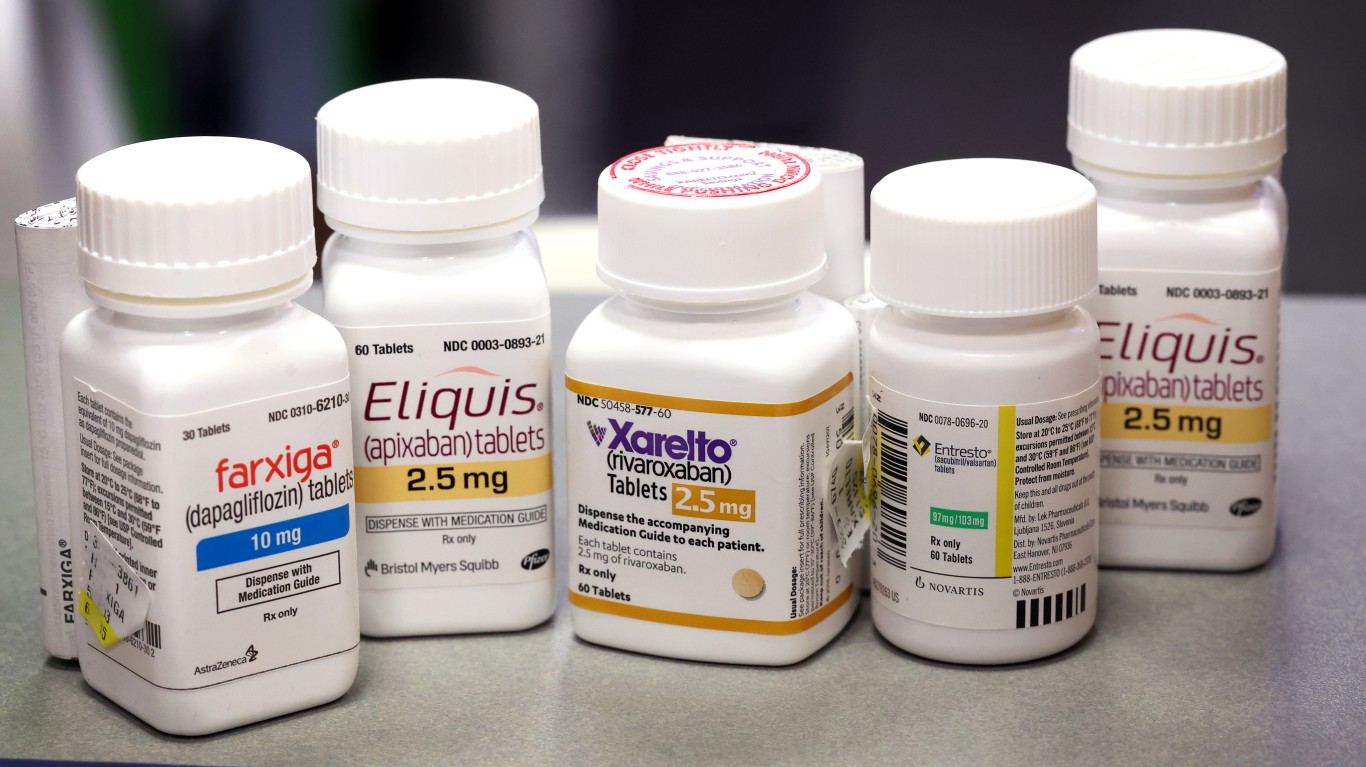Special Report
The First 9 Drugs Picked for Biden's Medicare Price Negotiations

Published:
Last Updated:

The Biden administration Tuesday announced the first 10 drugs that will be targeted for price negotiations with pharmaceutical companies, the start of the administration’s push to slash Medicare’s prescription drug costs. Among the drugs on the list are diabetes treatments Farxiga, Jardiance, and Januvia and blood thinners Eliquis and Xarelto.
In 2022, about 9 million Part D Medicare enrollees used the 10 drugs selected, according to the Office of the Assistant Secretary for Planning and Evaluation, U.S. Department of Health and Human Services. Medicare Part D is the part of Medicare that covers most outpatient prescription drugs. And these 65 and older Americans paid $3.4 billion in out-of-pocket costs for these 10 drugs in 2022. (See the leading causes of death for every age group in America.)
Of the drugs chosen for negotiated prices, Eliquis and Xarelto were first and third in covered prescription drug costs from June 2022 to May 2023. They were also first and third in the number of Medicare enrollees who used the drug from June 2022 to May 2023.
Unlike nations such as Germany and Japan whose governments negotiate drug prices, the U.S. has not had a mechanism for doing so. That changed after the passage of the Inflation Reduction Act in 2022, which gave the U.S. government greater leverage in negotiating drug costs. The act passed along party lines last year. The new negotiated prices for the first 10 drugs would take effect in 2026. Over the next four years, Medicare will negotiate prices for up to 60 drugs that are covered under Medicare Parts D and B, and up to 20 more drugs every year after that.
If drugmakers balk at negotiating prices, they can face stiff fines. They can also choose to leave Medicare and other government programs, although that would be costly since much of their profit is derived from their participating in those programs.
Opponents of the initiative claim it is unconstitutional, and the pharmaceutical industry contends that negotiated pricing will impact the financial rewards for innovation and research. (Also see the states where the COVID-19 surge is the worst right now.)
In a joint statement, GOP chairmen of the House Ways & Means Committee and the Energy & Commerce Committee and a Republican member of the Senate Finance Committee said the Inflation Reduction Act “will raise prescription drug prices — worsen patients’ access to care, destroy new cures before they come to market, eliminate American jobs, threaten the United States’ leading role in innovative research, and create potential constitutional concerns around government overreach.”
Click here to see the first set of drugs selected for Medicare price negotiation.

Eliquis
> Commonly treated conditions: Prevention and treatment of blood clots
> Covered prescription drug costs from June 2022-May 2023: $16,482,621,000
> Number of Medicare enrollees who used the drug from June 2022-May 2023: 3,706,000
> Average covered prescription drug costs per enrollee: $4,448
[in-text-ad]

Jardiance
> Commonly treated conditions: Diabetes; Heart failure
> Covered prescription drug costs from June 2022-May 2023: $7,057,707,000
> Number of Medicare enrollees who used the drug from June 2022-May 2023: 1,573,000
> Average covered prescription drug costs per enrollee: $4,487

Xarelto
> Commonly treated conditions: Prevention and treatment of blood clots; Reduction of risk for patients with coronary or peripheral artery disease
> Covered prescription drug costs from June 2022-May 2023: $6,031,393,000
> Number of Medicare enrollees who used the drug from June 2022-May 2023: 1,337,000
> Average covered prescription drug costs per enrollee: $4,511
Januvia
> Commonly treated conditions: Diabetes
> Covered prescription drug costs from June 2022-May 2023: $4,087,081,000
> Number of Medicare enrollees who used the drug from June 2022-May 2023: 869,000
> Average covered prescription drug costs per enrollee: $4,703
[in-text-ad-2]
Farxiga
> Commonly treated conditions: Diabetes; Heart failure; Chronic kidney disease
> Covered prescription drug costs from June 2022-May 2023: $3,268,329,000
> Number of Medicare enrollees who used the drug from June 2022-May 2023: 799,000
> Average covered prescription drug costs per enrollee: $4,091

Entresto
> Commonly treated conditions: Heart failure
> Covered prescription drug costs from June 2022-May 2023: $2,884,877,000
> Number of Medicare enrollees who used the drug from June 2022-May 2023: 587,000
> Average covered prescription drug costs per enrollee: $4,915
[in-text-ad]

Enbrel
> Commonly treated conditions: Rheumatoid arthritis; Psoriasis; Psoriatic arthritis
> Covered prescription drug costs from June 2022-May 2023: $2,791,105,000
> Number of Medicare enrollees who used the drug from June 2022-May 2023: 48,000
> Average covered prescription drug costs per enrollee: $58,148
Imbruvica
> Commonly treated conditions: Blood cancers
> Covered prescription drug costs from June 2022-May 2023: $2,663,560,000
> Number of Medicare enrollees who used the drug from June 2022-May 2023: 20,000
> Average covered prescription drug costs per enrollee: $133,178

Stelara
> Commonly treated conditions: Psoriasis; Psoriatic arthritis; Crohn’s disease; Ulcerative colitis
> Covered prescription drug costs from June 2022-May 2023: $2,638,929,000
> Number of Medicare enrollees who used the drug from June 2022-May 2023: 22,000
> Average covered prescription drug costs per enrollee: $119,951
If you’re one of the over 4 Million Americans set to retire this year, you may want to pay attention.
Finding a financial advisor who puts your interest first can be the difference between a rich retirement and barely getting by, and today it’s easier than ever. SmartAsset’s free tool matches you with up to three fiduciary financial advisors that serve your area in minutes. Each advisor has been carefully vetted, and must act in your best interests. Start your search now.
Don’t waste another minute; get started right here and help your retirement dreams become a retirement reality.
Thank you for reading! Have some feedback for us?
Contact the 24/7 Wall St. editorial team.